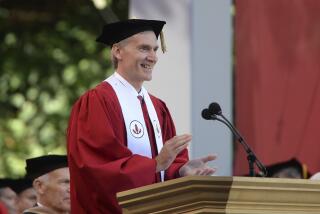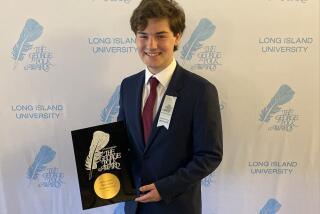Fusion Genieâs Still in Bottle, Scientistsâ Critics Say : What Started as a Triumphant Saga Fizzles Into Confusion and Carping
On March 23, two elated chemists--B. Stanley Pons and Martin Fleischmann--stood before reporters at a University of Utah news conference, proudly explaining how their discovery of nuclear fusion in a flask would lead to a worldwide abundance of cheap, clean energy. Afterward, they autographed press releases for colleagues and showed off their suddenly famous laboratory to visiting members of the news media.
That was less than seven weeks ago. On Monday night in Los Angeles, a starkly contrasting scene unfolded as the two mumbled through presentations before a throng of fellow chemists at the Bonaventure Hotel, ducked sharp questions and then slipped quickly away after failing to defend their supposed breakthrough.
The Pons-Fleischmann saga is beginning to raise troubling questions about the lure of patents and prizes in scientific discovery, about institutional and governmental pressures to attract recognition and money, and about the adverse effects of competition on scientific credibility.
Suddenly, there is no more talk of a Nobel Prize. The two chemists are besieged by critics--castigated for their inability to explain their experiment, their failure to reveal full details of the research and their decision to circumvent the normal rules of science by announcing their results at a press conference before reporting them at a meeting or publishing them in a scientific journal.
âI guess weâve all been guilty of eagerness,â James J. Brophy, the University of Utahâs vice president for research and development, conceded Tuesday.
Meanwhile, people around the world--tantalized by the idea of an energy miracle--are now left wondering: Is fusion in a flask real or simply the delusion of two scientists carried away by their own misguided enthusiasm?
If the Utah researchers have not found cold fusion, what have they found? One possibility is a previously undiscerned chemical reaction. If that is the case, they may have found a new way to make batteries, but no solution to energy problems.
The other most likely possibility is that they simply made a mistake.
The final answer may not come for weeks or months, until Pons and Fleischmann have had more time to refine their experiments and to share their data with other researchers.
One hope for resolving the quandary is a joint project with the Los Alamos National Laboratory. Two weeks ago, Pons said that a fusion flask would be set up in Salt Lake City in cooperation with Los Alamos researchers, then moved to Los Alamos where researchers can use sophisticated equipment to look for signs of a nuclear reaction.
Pons said Monday, however, that the project could not be started until necessary paper work has been completed.
Meanwhile, the governor of Utah has created a nine-member panel that will oversee a $5-million fund for fusion research created by the state Legislature. Those funds cannot be disbursed until Ponsâ and Fleischmannâs claims have been corroborated. The University of Utahâs Brophy said Tuesday that the panel will be given access to all of the researchersâ data--the first time that anyone outside the university will have seen it.
It is hoped that the panel will complete its evaluation before within two weeks.
Pons and Fleischmann were an unlikely pair from the beginning. The rumpled Fleischmann, 62, has a long and distinguished history that brought him the chairmanship of the chemistry department of the University of Southampton in England and numerous awards before he retired from teaching in 1983.
Pons Rose Quickly
In contrast, the peripatetic Pons, 45, had dropped out of graduate school at the University of Michigan in 1967, first to join his familyâs textile business, then to operate a restaurant in Florida. He met Fleischmann in 1975 when he returned to graduate school, choosing the University of Southampton because it would allow him to transfer most of the credits he had already earned. Pons rose quickly, becoming chairman of the University of Utahâs highly respected chemistry department.
Spurred by shared interests in skiing and cooking, Pons and Fleischmann became close friends, spending long periods in each otherâs homes and collaborating on a variety of projects. Their continued scientific conversations ultimately led to their new approach to fusion, which Fleischmann has always said was a âone-in-a-billion shot.â
Their apparatus is simple, small palladium and platinum electrodes immersed in heavy water--water in which each of the hydrogen atoms has an extra neutron. Applying a small voltage to the electrodes, they said, creates an electrical field that forces high concentrations of deuterium ions into the palladium electrode. At those high concentrations, the deuterium ions fuse to form helium, releasing large quantities of energy.
They convinced themselves that their apparatus was producing more energy than they were putting into it and that they were observing radioactive debris in the reaction vessel that could only have arisen from a nuclear fusion reaction.
The pair spent 5 1/2 years and $100,000 of their own money researching the phenomenon. Earlier this year, they discovered that physicist Steven Jones of Brigham Young University in Provo and his colleagues were working on the same technique. Jones was also seeing radioactive debris, but he did not observe significant heat production and did not believe that the process could be used for large-scale energy production.
The two groups met early in March and ultimately agreed to publish their findings simultaneously. Pons and Fleischmann said it would take them another 18 months before they were ready to publish, but Jones objected that an abstract of his work was already being circulated among scientists and that he planned to present the results soon.
It was agreed that the two groups would each submit a paper to the British journal Nature on March 24. But without warning, Jones, Pons and Fleischmann announced their findings on March 23, simultaneously filing patent applications. Jonesâ paper was published two weeks ago; Pons and Fleischmann withdrew theirs when the journal asked for more experimental details.
They did write a brief explanation of their results, which appeared in a Dutch journal, and they gave cursory descriptions at a meeting of the American Chemical Society and other meetings. But most of their experimental details remained obscure.
Many researchers, already angered by the lack of detail, were further incensed two weeks ago when the pair, accompanied by university officials, went before a U.S. Senate committee to ask for $25 million for a fusion research center in Salt Lake City. That money would join the $5 million already appropriated by the Utah Legislature and an additional $70 million the University of Utah hopes to raise from industry.
Because of the potential application of the Utah results to energy production, thousands of scientists around the world put aside research projects and began trying to replicate the fusion results--usually basing their experiments on newspaper descriptions of the fusion cell.
Within three weeks, reports of partial confirmation began to appear in the United States and around the world, usually from small research groups lacking access to sophisticated analytical tools. Several of the groups withdrew their claims, citing experimental errors.
Such initial confirmation is common, said physicist Douglas Morrison of the European Center for Nuclear Research. Many researchers want to âget on the bandwagon,â he said, and thus make premature claims of success.
Find No Evidence
Last week, at a meeting of physicists in Baltimore, spokesmen for the 11 U.S. Department of Energy research laboratories, as well as comparable facilities in Canada and England, reported that they could find no evidence for fusion or for excess heat production.
Many others found experimental errors in Ponsâ and Fleischmannâs data, concluding that the Utah researchersâ calculations of the energy produced in the cell were probably based on faulty assumptions. In short, said Caltech chemist Nathan Lewis, âWe find no evidence for anything other than conventional chemistry.â
Monday night, for the first time, the Utah researchers conceded that they too had been troubled by some of the measurements. But, even then, they continued to stick by their claim to have produced excess heat.






